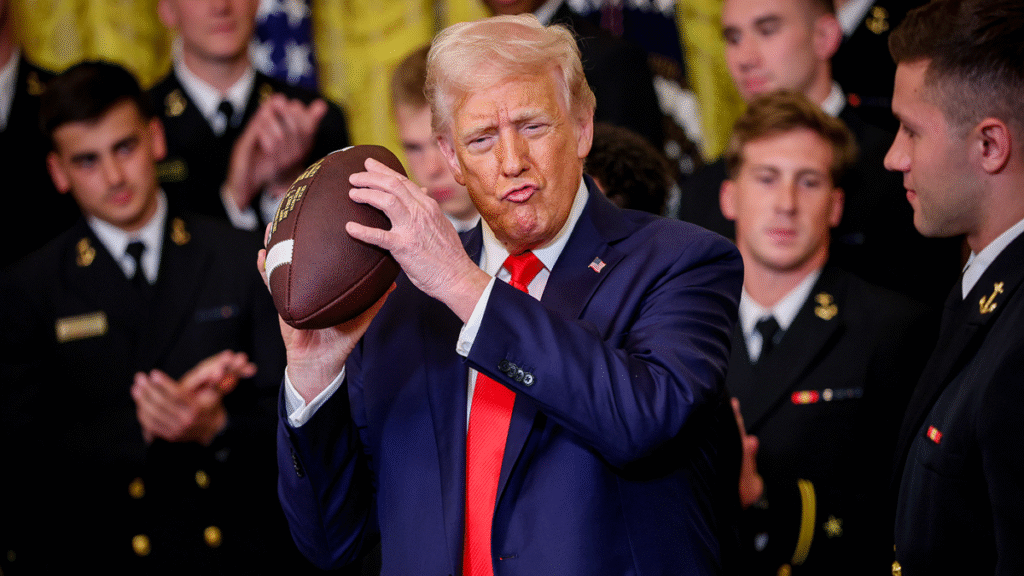President Donald Trump officially inserted himself into the college sports conversation on Thursday by issuing his first major executive order related to college sports. Titled “Saving College Sports,” the order promises sweeping and binding changes to help tame the wild college athletics landscape.
The executive order repeats many of the precepts of the House v. NCAA settlement and seems to codify a number of policy points set out by the College Sports Commission. It bans pay-for-play payments by third parties, including collectives, instead mirroring the CSC’s call for legitimate business purposes. The document also takes direct aim at non-revenue sports by requiring schools to preserve and expand scholarship opportunities.
It’s a big, beautiful order that appears to settle some of the biggest questions facing college athletics. The only problem? It doesn’t really do anything.
Now, some of this gets a little technical. An executive order has the ability to direct organizations in the executive branch to handle some cases certain ways, or to prioritize certain things. Think of it like a company-wide memo sent in a corporation — everyone will read it and have thoughts, but the board has to vote on any real decision.
President Donald Trump signs executive order prohibiting ‘third-party, pay-for-play payments’ to athletes
Will Backus
What an executive order doesn’t do is create any new laws. For that to happen, we have to go back to Schoolhouse Rock. There are a few bills proposed, most notably the SCORE Act, but they’re all stuck in limbo. None of them have passed. As a result, there are no new legal protections available. None of the legal questions about antitrust, employment or compensation caps are resolved in any actionable way.
Additionally, the pay-for-play ban only echoes existing legislation. The real fight about collectives surrounds whether the money flowing through them actually represents any legitimate business purpose. That issue remains in the air despite the order and will likely end in further lawsuits down the road.
The executive branch does have some levers of power that it can use to pressure the state of college athletics. For one, on the non-revenue sport front, the Trump administration has not been shy to cut funding to universities on a whim. Doing so might not hold up to legal challenges long term, but getting into multi-year litigation isn’t good for any school.
Additionally, the order does require the National Labor Relations Board to formally clarify the status of athletes, which could have significant implications on whether they’re eligible to collectively bargain. The attorney general and Federal Trade Commission offices will also have 60 days to evaluate status and create plans to clarify and defend athlete rights. Firm deadlines will inspire at least some movement.
However, more than anything else, the executive order does change one thing: It puts college sports high on the agenda for Capitol Hill.
There are numerous bills that have been proposed over the years to address the state of athlete compensation, including several that involved both sides of the aisle. Former Stanford player Cory Booker, former Auburn football coach Tommy Tuberville and Texas senator Ted Cruz rank among the numerous senatorial dignitaries who have worked to get bills passed to no avail.
And, to his credit, Trump didn’t try to do too much with his executive order. Instead of claiming massive structural change that would require Congressional action to have any real staying power, Trump instead picked a direction. For it to really matter, Congress has to act next.
In a combined statement, the Autonomy Five conferences reiterated their desire for legislation, not just an executive order.
“This executive order builds on the momentum created by the bipartisan SCORE Act, which will provide long-term stability to college sports… we hope Congress sends federal legislation to President Trump’s desk as soon as possible,” the group wrote.
Trump has been no stranger to college athletics during his time in politics. He has attended several games over the years, including the 2024 matchup between Alabama and Georgia at Bryant-Denny Stadium. The Tide shocked Georgia 41-34 on a game-winning 75-yard touchdown by Ryan Williams with 2:18 remaining.
In previous months, Trump has engaged repeatedly with Nick Saban and Texas Tech megabooster Cody Campbell, including a rumored commission involving both figures. However, the executive order is the clearest signal yet that the Trump Administration is ready to wade into the murkiest waters in college athletics history.
The fact sheet put out by the White House claims Trump “Save[d] College Sports” with the stroke of a pen on Thursday. In reality, the executive order itself doesn’t mean much. But more importantly, Washington, D.C., now has its full attention on college football. Six months from now, we’ll see if that was a blessing or a curse.
Read the full article here


